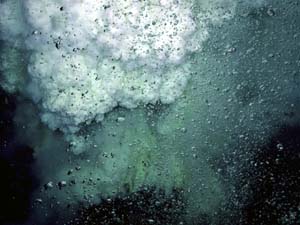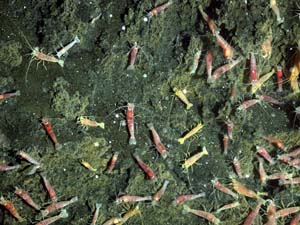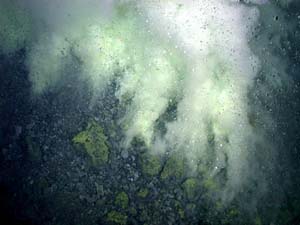| NOAA Magazine || NOAA Home Page |
EXPLORERS DISCOVER UNDERSEA VOLCANO'S LONG-TERM ERUPTION
 May
24, 2006 � A NOAA-led team of ocean explorers returned this month with
new and dramatic video and sound recordings of a long-term deep-sea
volcanic eruption first discovered in 2004 on the Mariana Arc. The
site, with red lava and spewing sulphur and rocks, has been seen erupting
on three visits in two years and provides a unique opportunity for scientists
to study underwater volcanic activity. (Click NOAA image for
larger view of a de-gassing event at Brimstone Pit at NW Rota-1 volcano
releasing an extraordinary number of bubbles—probably carbon dioxide.
The yellow parts of the plume in the background contain tiny droplets
of molten sulfur. Click
here for high resolution version. Please credit “NOAA.”)
May
24, 2006 � A NOAA-led team of ocean explorers returned this month with
new and dramatic video and sound recordings of a long-term deep-sea
volcanic eruption first discovered in 2004 on the Mariana Arc. The
site, with red lava and spewing sulphur and rocks, has been seen erupting
on three visits in two years and provides a unique opportunity for scientists
to study underwater volcanic activity. (Click NOAA image for
larger view of a de-gassing event at Brimstone Pit at NW Rota-1 volcano
releasing an extraordinary number of bubbles—probably carbon dioxide.
The yellow parts of the plume in the background contain tiny droplets
of molten sulfur. Click
here for high resolution version. Please credit “NOAA.”)
The eruption
is at Brimstone Pit, a vent high on the side of the large submarine
volcano
NW Rota-1, located about 37 miles northwest of the island of Rota, in
the Northern Mariana Islands. The volcano is one of many on the Mariana
Arc, part of the "Submarine Ring of Fire" that circles the
Pacific Ocean basin, where tectonic plates spread or collide.
"In three international expeditions spanning more than two years, we've discovered a submarine volcano erupting perhaps continuously and often violently, spewing rocks that sometimes forced us to back away our remotely operated vehicles," said Bob Embley, an oceanographer with the NOAA Pacific Marine Environmental Laboratory in Newport, Ore., and chief scientist on missions in 2004 and 2006. "But with those underwater robots, we could often get in close to take compelling images and to sample the chemistry in ways not possible with volcanoes on land."
 A
paper in the May 25 issue of the science journal Nature with Embley
as lead author, reports findings from the NOAA-sponsored expedition
to the site in 2004, and from an expedition in 2005 sponsored by the
Japanese Agency for Marine-Earth Science and Technology (JAMSTEC), and
led by JAMSTEC's Yoshihiko Tamura. The paper presents the first observations
of a deep-sea eruption on a submarine arc volcano and its effects on
the surrounding ocean, and describes plumes of sulfur-rich fluids and
volcanic ash expelled in pulses from a crater that in 2004 measured
nearly 50 feet in diameter at a depth of about 1,800 feet. (Click
NOAA image for larger view of a close-up of shrimp living near seafloor
hot-springs at NW Rota-1 volcano. The yellowish coating on some of the
shrimp is apparently from iron or sulfur that accumulates on their carapace.
The pinker shrimp probably have molted more recently. Click
here for high resolution version. Please credit “NOAA.”)
A
paper in the May 25 issue of the science journal Nature with Embley
as lead author, reports findings from the NOAA-sponsored expedition
to the site in 2004, and from an expedition in 2005 sponsored by the
Japanese Agency for Marine-Earth Science and Technology (JAMSTEC), and
led by JAMSTEC's Yoshihiko Tamura. The paper presents the first observations
of a deep-sea eruption on a submarine arc volcano and its effects on
the surrounding ocean, and describes plumes of sulfur-rich fluids and
volcanic ash expelled in pulses from a crater that in 2004 measured
nearly 50 feet in diameter at a depth of about 1,800 feet. (Click
NOAA image for larger view of a close-up of shrimp living near seafloor
hot-springs at NW Rota-1 volcano. The yellowish coating on some of the
shrimp is apparently from iron or sulfur that accumulates on their carapace.
The pinker shrimp probably have molted more recently. Click
here for high resolution version. Please credit “NOAA.”)
A 2006 NOAA-sponsored mission completed earlier this month obtained new and dramatic video and audio recordings of the continuing eruption. An interdisciplinary team of 21 scientists from the U.S., Japan, Canada and New Zealand sailed on the research vessel Melville, operated by the Scripps Institution of Oceanography. The science team worked closely with the Deep Submergence Operations Group of Woods Hole Oceanographic Institution to use the remotely operated vehicle Jason II to explore and collect samples on nine different active submarine volcanoes. A chronicle of the mission, including eruptive sounds and images, is online.
 Bill
Chadwick, a geologist at Oregon State University and the NOAA
Vents Program, was on the 2004 and 2006 expeditions. "The eruptive
activity at Brimstone Pit, although violent at times, is usually limited
to a small area because of the dampening effect of the surrounding water,"
he said. "The pressure of 1837 feet of water over the site reduces
the power of the explosive bursts, and the water quickly slows down
the rocks and ash that are violently thrown out of the vent. Most of
the time, the underwater robot Jason could hover about 10 feet away
and watch for hours. You could never do that on land," he said.
"We could also see the release of volcanic gases from the erupting
lava with new clarity with the help of the streams of bubbles and multicolored
plumes as they were emitted." (Click NOAA image for larger
view of pieces of lava coated in yellow sulfur that stand out at the
leading edge of an advancing lava flow on the seafloor at NW Rota-1
volcano. Bubbles of carbon dioxide also are streaming upwards as gases
escape from the lava. Click
here for high resolution version. Please credit “NOAA.”)
Bill
Chadwick, a geologist at Oregon State University and the NOAA
Vents Program, was on the 2004 and 2006 expeditions. "The eruptive
activity at Brimstone Pit, although violent at times, is usually limited
to a small area because of the dampening effect of the surrounding water,"
he said. "The pressure of 1837 feet of water over the site reduces
the power of the explosive bursts, and the water quickly slows down
the rocks and ash that are violently thrown out of the vent. Most of
the time, the underwater robot Jason could hover about 10 feet away
and watch for hours. You could never do that on land," he said.
"We could also see the release of volcanic gases from the erupting
lava with new clarity with the help of the streams of bubbles and multicolored
plumes as they were emitted." (Click NOAA image for larger
view of pieces of lava coated in yellow sulfur that stand out at the
leading edge of an advancing lava flow on the seafloor at NW Rota-1
volcano. Bubbles of carbon dioxide also are streaming upwards as gases
escape from the lava. Click
here for high resolution version. Please credit “NOAA.”)
"Locally, carbon dioxide forms waterfalls of bubbles in front of the advancing lava," said Cornel de Ronde, a geologist with New Zealand's Institute of Geological & Nuclear Sciences, when describing Brimstone Pit. "It is these different gases that are the force behind the vigorous 'mini-explosions' within the lava flow."
Verena Tunnicliffe, the Canada Research Chair in Deep Oceans and professor at the University of Victoria, Canada, was on the 2006 mission to study chemosynthetic life—life based on chemicals. "On NW Rota, not many animals would want to live on an erupting volcano, but two feisty shrimp species are able to reap the benefits of the volcano's hydrothermal activity where heated fluids are full of reduced chemicals that foster the growth of bacteria. Bacterial mats coat many rock and rubble surfaces thus forming an abundant food source for animals that can use such mats," she said.
At Daikoku Volcano on the northern part of the Mariana Arc chain, researchers found a pool of liquid sulfur at a depth of 1,365 feet with a "crust" moving in a wavelike motion from continuous flow of gas from below. Liquid sulfur and clouds of gases rich in hydrogen sulfide and other sulfur gases, could be linked to an unusually high density of chemosynthetic organisms found on Mariana submarine volcanoes.
"These expeditions are part of our mission to explore the ocean for the purpose of discovery and the advancement of knowledge," said Steve Hammond, acting director of the NOAA Office of Ocean Exploration. "They are critically important pathfinding missions that challenge us to understand the fundamental processes of the ocean and how they affect our lives."
NOAA, an
agency of the U.S. Department of
Commerce, is dedicated to enhancing economic security and national
safety through the prediction and research of weather and climate-related
events and providing environmental stewardship of the nation's coastal
and marine resources.
Through the emerging Global Earth Observation System of Systems (GEOSS),
NOAA is working with its federal partners, 61 countries and the European
Commission to develop a global network that is as integrated as the
planet it observes, predicts and protects.
Relevant Web Sites
NOAA Submarine
Ring of Fire 2006
NOAA Office of Ocean Exploration
Media
Contact:
Fred Gorell, NOAA
Office of Ocean Exploration, (301) 713-9444 ext. 181
(Photos courtesy of Submarine Ring of Fire 2006 Exploration, NOAA Vents
Program.)